Fast growing vegetables for quick harvests
From mid summer onwards, sow some fast growing vegetables for quick harvests from your garden. The ground is warm and therefore seeds will germinate quickly and grow on well. And because many of these crops will be used as young leaves and immature plants, they do not take up much space in your garden.
Wherever possible, sow seeds in damp soil, but not waterlogged soil and lightly cover with compost or soil.
Legumes
Peas, sugar snap, mangetout or snow peas. Choose short varieties that do not need to grow tall before producing flowers. Alternatively, sow peas to harvest the pea shoots as a tasty addition to salads or as a garnish. Pea shoots taste of fresh peas.

Bush beans or dwarf French beans can produce a good crop of beans. Climbing beans sown in late July may produce a crop in good summers with a mild autumn, but growing bush beans means that plants do not need to grow so tall and therefore, will be quicker to produce flowers.
Brassica
Most of the suggestions in this section can be harvested for baby leaves or at the young leaf stage. Alternatively, leave some plants to grow on to produce mature plants to harvest during the winter months and into the hungry gap next year.
Kale
Baby and young kale leaves make a great addition to salads and stir-fry dishes. Cut leaves and leave stem and roots in the ground to regrow more leaves for up to 4 or 5 cuttings. Where space allows leave a few plants to mature to give you harvests throughout winter.
Kohl rabi
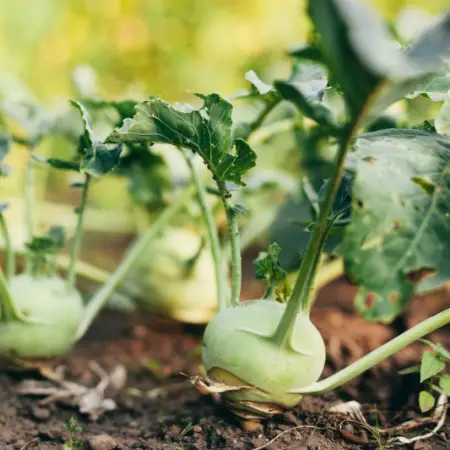
Quick to mature. In ideal growing conditions Kohl rabi is ready to harvest 45 – 60 days after sowing. In UK, that may take longer, but small kohl rabi taste just as delicious. Use raw in salads or cooked in main dishes or side dishes. It tastes of slightly sweet and lightly peppery cabbage.
Chinese kale
An interesting fast growing vegetable. The stems, leaves and flowers are edible.
Pak Choi
A popular choice for using to fill spaces in the garden. The flavour is a mix between cabbage and spinach. It is easy to cook with pak choi, making it a useful vegetable in the kitchen.
Chard
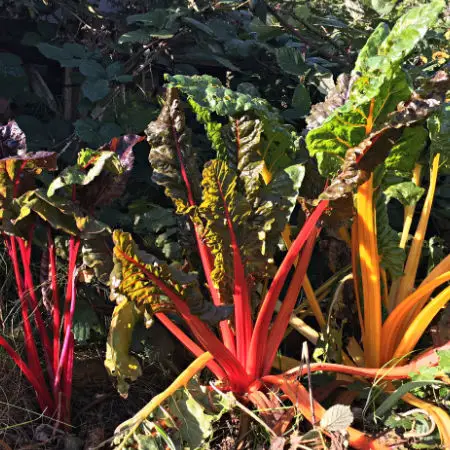
A real workhorse in the vegetable garden. The baby leaves and young leaves can be used in salads. Mature leaves can be used as a vegetable in a variety of dishes or as a side dish. The stalks can be roasted to add an earthy note to a bowl of mixed roast vegetables. Continue to harvest chard even when it starts to go to seed in the spring. Unlike spinach, the leaves of chard do not become bitter.
Arugula / rocket
Harvest young leaves to add to salads and sandwiches. Wilted leaves make an interesting side dish. Additionally, leave some plants to grow to maturity and enjoy the flowers as an edible garnish.
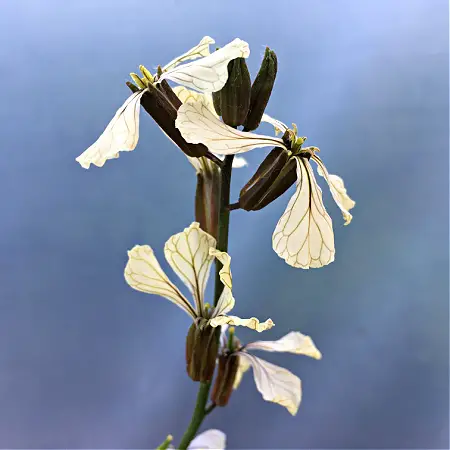
Leafy greens
Spinach
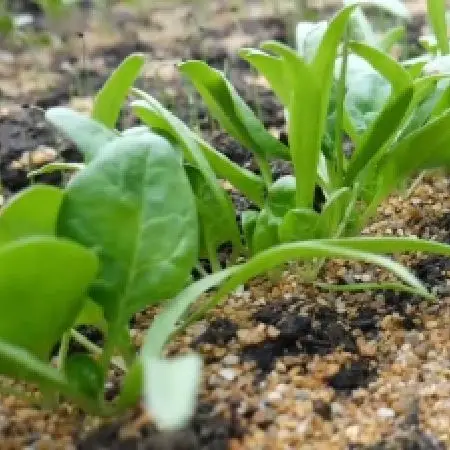
It is much cheaper to grow your own baby spinach leaves than purchase in a supermarket in a bag. Sow at three to four week intervals throughout the growing season. Spinach generally prefers cooler weather, therefore growing from late summer onwards is ideal.
Chop suey greens (Chrysanthemum Coronarium)
Grow for young leaves to add a tangy, aromatic flavour to dishes. Once it starts to form flowers, the leaves become bitter.
Beet leaves
Easy to grow, sow seeds at regular intervals for a continuous supply of young leaves. If left to mature, the plants will form beets (see below). Growing a selection of varieties gives different colour stems to add interest to the look of salads.
Perilla Shiso
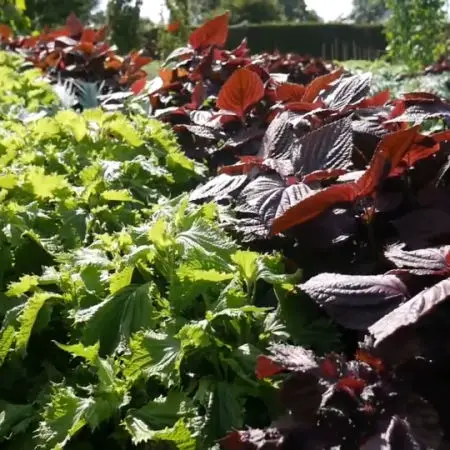
Another option for baby leaf salads. Has pungent aroma and taste, so a little can go a long way! Red perilla has an anise-like flavour, while green perilla has a stronger, cinnamon flavour. Perfers well-draining soil and plenty of sunshine. As seeds need light to germinate a minimal covering with compost will suffice. Mature leaves will be ready to pick in around 8 weeks, but young leaves can be harvested sooner.
Lettuce
Choose open head varieties, cut and come again or oak leaf type lettuces. Harvest regularly from the outside to allow the plant to continue growing more leaves.
Mizuna/Mibuna
These are lightly spicy leaves that are tolerant of cooler temperatures. Plants grow in a rosette to around 20cms (8 inches) tall.
Mustard
There are a range of mustard varieties that can be sown and harvested in a few weeks’ time. As with many of the plants grown for young leaves, sow at intervals throughout the season to have a continuous supply. A wide choice of leaf shape and colour is available.
Herbs
- Dill
- Parsley
- Cilantro/Coriander
- Herb fennel
Allium
Scallions, also known as spring onions will produce leaves for cutting. They may not produce large plants before winter, however most varieties are hardy unless you have a severe winter. Choose a faster growing variety like Guardsman or Performer.
Chives will produce small leaves for cutting before the first frosts. It is hardy perennial herb, so can be left in the ground to grow on.
Root vegetables for quick harvests
Carrots
Baby carrots can be harvested in 30 – 40 days from sowing, and larger carrots in around 60 – 80. Sow seeds on to damp soil, cover lightly with compost or more soil and then ensure that the seeds do not dry out during germination. Cover the seeds with a sheet of card or plank of wood and check daily for signs of first leaves. As soon as you can see the seedlings, remove the card or wood and allow to grow on.
Turnips
Fast to mature, turnips can be harvested in as few as five weeks from sowing. There is a wide range of varieties to choose from.
Summer radishes
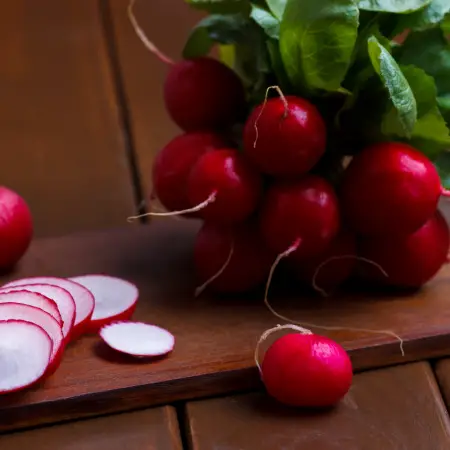
Often the first seeds we sow as learner gardeners and for a good reason! Radishes are quick to germinate and to reach maturity. Harvest can be as little as three to five weeks. Sow little and often to have a continuous supply of summer radishes.
Beetroot
Beets or beetroots are available in a range of shapes and colours. White beets have a milder flavour than deep red beets and all offer something to the kitchen gardener. Seeds sown in late summer will provide a harvest of baby beets before the first frosts. Beetroot is hardy, in all but the harshest of winters, so can be left in the ground to grow and harvested as needed.
The above are suggestions for fast growing vegetables. There are other seeds that can be sown in late summer to provide harvests for next year, in particular, during the hungry gap. My guide of what to sow in August offers plenty of ideas for your vegetable garden.
Where to find seeds for fast growing vegetables
The first place to look for seeds is your existing seed stash and then if you need to buy seeds, head to your preferred seed seller. You can often find discounted seeds by mid-season, which makes your vegetable gardening even better value for money. If you can, support small or independent businesses that sell organic or open pollinated seeds.
In UK, try Real Seeds, Tamar Organics, Vital Seeds and the organic section at Premier Seeds Direct.
In USA, get 10% discount when you visit MI gardener and use the code BYTHERFARM at checkout. And check out Baker Creek Heirloom Seed Company.
If you know of other small or independent seed sellers, please leave a comment below this article. In particular, it would be good to know of retailers in mainland Europe, Australia and New Zealand.
- Ball Shaped Flowers - October 24, 2025
- 10 Shrubs for Summer Colour - October 10, 2025
- Contrasting flower colours - September 26, 2025

Liz you are amazing. Love watching your channel, and am blessed to have a person like you to be able to climb upon your shoulders for knowledge. May many keep coming to keep your cup/channel overflowing. Shalom shalom.